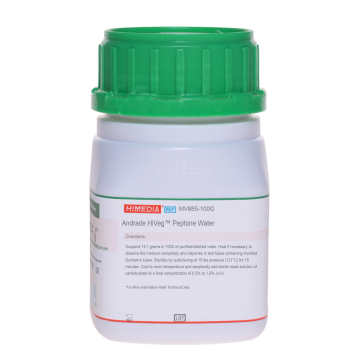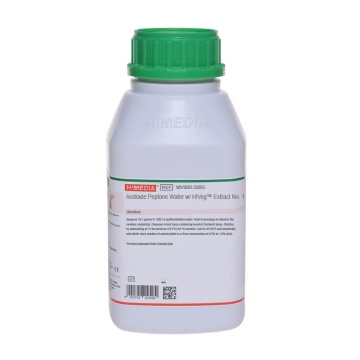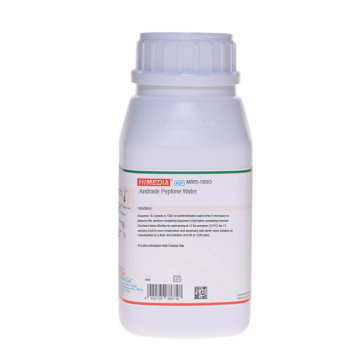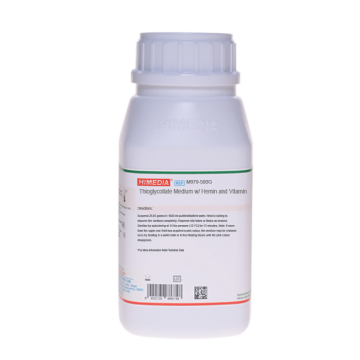 Your enquiry has been submitted
Your enquiry has been submitted
Enteric Fermentation Base
Enteric Fermentation Base is used with added carbohydrate and indicator for differentiating microorganisms based on fermentation reactions.
Composition**
| Ingredients | Gms / Litre |
|---|---|
| Beef extract | 3.000 |
| Peptic digest of animal tissue | 10.000 |
| Sodium chloride | 5.000 |
Final pH (at 25°C): 7.2±0.1
**Formula adjusted, standardized to suit performance parameters
Directions
Suspend 18 grams in 1000 ml distilled water. Add 10 ml of Andrade's indicator. Heat if necessary to dissolve the medium completely. Add the test carbohydrate in desired quantity (0.5% or 1%). Mix well and dispense into tubes containing inverted Durhams tube. Sterilize by autoclaving at 15 lbs pressure (121°C) for 15 minutes.
Principle And Interpretation
Bacteria are differentiated by the carbohydrates they utilize and the types and quantities of acid produced. These differences in enzymatic activity serve as one of the important characteristic by which different species are recognized. This serves as an important criterion in their identification (1- 4). A variety of different liquid or agar media can be used to measure the ability of test organism to fermentatively utilize carbohydrates. The principle of carbohydrate fermentation is based on Pasteurs studies of bacteria and yeasts, which state that the action of many species of microorganisms on a carbohydrate substrate results in acidification of the medium. The term fermentation is also used in reference to the utilization of carbohydrates by bacteria. Fermentation is an oxidation- reduction metabolic process that takes place in an anaerobic environment, and an organic substrate serves as the final hydrogen (electron) acceptor. This process is detected by observing colour changes in the pH indicator, as acid products are formed.
A basal medium for determining the fermentation reactions of microorganisms must be capable of supporting growth of test organisms and be free from fermentable carbohydrates. Enteric Fermentation Base is prepared according to the formula described by Edwards and Ewing (5).
Beef extract and peptic digest of animal tissue provide the carbon and nitrogen sources required for good growth of a wide variety of organisms. Sodium chloride maintains the osmotic balance of the medium. The microorganisms tested are differentiated by their ability to ferment a particular carbohydrate that has been added to the Enteric Fermentation Base. The desired carbohydrate is added to the medium either before or after sterilization. The fermentation and resultant acid production are indicated by a change in color of the pH indicator (Andrades indicator) present in the medium from light amber to dark pink to red. Gas produced during fermentation by fermenting bacteria is indicated by gas bubbles collected in inverted Durhams tubes. Negative tubes remain colourless and should be observed regularly for a total of 30 days.
Quality Control
Appearance: Cream to light tan homogeneous free flowing powder
Colour and Clarity of prepared medium: Light pink coloured, clear solution in tubes
Reaction: Reaction of 1.8% w/v aqueous solution at 25°C. pH : 7.2±0.1
pH: 7.10-7.30
Cultural Response
M1662: Cultural characteristics observed after an incubation at 35-37°C for 18- 24 hours.
| Organism | Inoculum (CFU) | Growth | Acid without dextrose | Gas without dextrose | Acid with dextrose | Gas with dextrose |
|---|---|---|---|---|---|---|
| Escherichia coli ATCC 25922 | 50-100 | good | negative reaction, no colour change or pinkish amber | negative reaction | positive reaction, red colour | positive reaction |
| Salmonella Typhimurium ATCC 14028 | 50-100 | good | negative reaction, no colour change or pinkish amber | negative reaction | positive reaction, red colour | positive reaction |
| Shigella flexneri ATCC 12022 | 50-100 | good | negative reaction, no colour change or pinkish amber | negative reaction | positive reaction, red colour | negative reaction |
Storage and Shelf Life
Store below 30°C in tightly closed container and the prepared medium at 2 - 8°C. Use before expiry date on the label.
Reference
- Ewing, 1986, Edwards and Ewings Identification of Enterobacteriaceae, 4th Edition, Elsevier Science Publishing Co., Inc., New York, N.Y.
- Forbes B. A., Sahm A. S., and Weissfeld D. F., Bailey & Scotts Diagnostic Microbiology, 10th Ed., 1998, Mosby, Inc., St. Louis, Mo.
- Holt, Krieg, Sneath, Staley and Williams (Ed.), 1994, Bergeys Manual of Determinative Bacteriology, 9th Ed., Williams & Wilkins, Baltimore, Md.
- Murray P. R., Baron J. H., Pfaller M. A., Jorgensen J. H. and Yolken R. H., (Eds.), 2003, Manual of Clinical Microbiology, 8th Ed., American Society for Microbiology, Washington, D.C.
- Edwards and Ewing, 1972, Identification of Enterobacteriaceae, 3rd Ed., Burgess Publishing Co., Minneapolis, Minn.
| Product Name | Enteric Fermentation Base |
|---|---|
| SKU | M1662 |
| Product Type | Regular |
| Physical Form | Powder |
| Origin | Animal |
| Packaging type | HDPE |
| References | 1. Ewing, 1986, Edwards and Ewings Identification of Enterobacteriaceae, 4th Edition, Elsevier Science Publishing Co., Inc.,New York, N.Y. |
| Customized Product Available | No |












